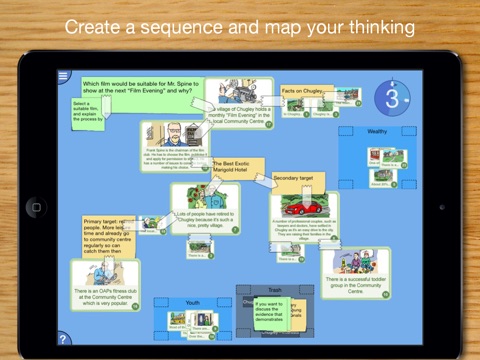
Digital Mysteries: KS3/4 app for iPhone and iPad
Developer: Reflective Thinking
First release : 04 Mar 2015
App size: 26.03 Mb
Digital Mysteries: KS3/4 is a curriculum-based app that is unique in allowing pairs to work simultaneously on one iPad with tasks that are designed to encourage discussion and higher-level thinking.
Users are given illustrated slips of information which they read, organise into groups and then sequence to represent their thought pattern of how they came to their answer. This is in response to the open-ended question for each particular task.
Students can generate a PDF session report which can be shared or printed, plus they can move to a Reflection Stage. This involves sitting as a group, with their teacher, or as a class, and playing back the app session to help them reflect on it.
Who is this app for?
This version has two tasks for 11-16 year olds (KS3/4) as a taster of the variety of mysteries we have. While those in this app are for Geography and Media, please tap Developer Apps at the bottom of the app details tab to see our others. Many more are coming soon including tasks for history and computing.
By having three levels within each task (mystery), it supports differentiation in class and can be suited to varying abilities/levels of knowledge. Each difficulty level may have a different number of slips, inclusion of abstract information and more/fewer hints for grouping and sequencing.
What is different about this app?
• Truly collaborative: It is unique in that more than one student can interact with it at once
• Curriculum-mapped: Tasks are directly mapped to the National Curriculum for England
• Retention: Working with information slips from two different perspectives (grouping, then fitting them in a sequence) ensures students remember more
• Higher-level thinking: The multiple discussion points combined with the tasks open-ended nature leads to students developing these skills
• Record of learning: Students can interact and have fun with exciting technology then print/share a PDF report of their session which shows what they’ve done
• Reflection: Sessions are recorded so students can playback and discuss them, emphasising the importance of the process as well as the outcome
• Engagement: Mysteries split bulks of information into short snippets which makes it more digestible, plus working with peers leads to higher engagement levels
• Cross-curricular: Tasks come in various topics plus some are cross-curricular in themselves
• Research: Weve done years of academic research on how to make the most of touch screens for learning
What does a mystery consist of?
• Illustrated slips of information: Including facts alongside story-based snippets about a particular character and their experiences
• Open question: To maximise the potential of collaboration, discussion, and expression of ideas, the nature of the task is usually open ended
• Extras: Most tasks come with personalised hints for those who need them. E.g. suggestions for grouping or sequencing slips
• Description: Gives teachers the information they need to plan their session including the curriculum point each task links to, the advised age range and possible learning outcomes
What mysteries come in this sample version?
Chugley Film Festival - Media
Question: Which film would be suitable for Mr. Spine to show at the next "Film Evening" and why?
This exemplifies how the mystery format can work well with various subjects and tasks. In particular, it can help students recognise different factors which affect marketing decisions, e.g. age. This is through a village called Chugley, the people who live there and their local amenities.
Boscastle Flooding - Geography
Question: Why is Colin facing his worst fears?
This task helps students learn about the causes and effects of flooding via a study on the Boscastle flood of 2004. It involves a local resident called Colin who got caught up in the floods, and while students sort through various facts and figures, they must work together to explore how the event may impact him in different ways.



